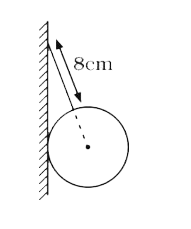Figure shown a clamped metal string of length and linear mass density . Which is taut at a tension of . A small rider piece of paper is placed on string at point as shown. An external vibrating tuning fork is brought near this string and oscillations of rider are carefully observed.

Now if the tensio in the string is made , at which of the following frequencies of turning fork , rider will not vibrate at all
None of these
The correct Answer is:C
Wave velocity in string is
Fundamental frequency of string oscillations is
Here rider will not oscillate at all only if it is at a node of stationary wave in all other cases of resonance and non resonance it will vibrate at the frequency of tuning fork. At a distance from one end node will appear at or similar higher Harmonics at frequencies
If string is divided in off no. of segments, these segments can never resonate simultaneously hence at the locaton of rider, antinode is never obtained at any frequency.
Similar Questions
Knowledge Check
Figure shown a clamped metal string of length 30cm and linear mass density 0.1kg/m. Which is taut at a tension of 40N. A small rider ( piece of paper ) is placed on string at point P as shown. An external vibrating tuning fork is brought near this string and oscillations of rider are carefully observed.

At which of the following frequencies of turning fork, rider will not vibrate at all :A1003HzB50HzC200HzDNone of theseFigure shown a clamped metal string of length 30cm and linear mass density 0.1kg/m. Which is taut at a tension of 40N. A small rider ( piece of paper ) is placed on string at point P as shown. An external vibrating tuning fork is brought near this string and oscillations of rider are carefully observed.

At which of the following frequencies the point P on string will have maximum oscillation amplitude among all points on string :A2003HzB100HzC200HzDNone of theseA string of length 0.5m and linear density 10−4 kg/m is stretched under a tension of 100 N. If the frequency of the vibration of the string is 4000 Hz, how many loops are formed on the string?
A1B4C2D6
A string of length 20 cm and linear mass density 0.40gcm−1 is fixed at both ends and is kept under a tension of 16 N. A wave pulse is produced at t = 0 near an end as shown in figure, which travels towards the other end. (a) When will the string have the shape shown in the figure again ? (b) Sketch the shape of the string at a time half of that found in part (a).

View SolutionA uniform sphere of weight W and radius 5 cm is being held by string as shown in the figure. The tension in the string will be

View SolutionA 5.5 m length of string has a mass of 0.035 kg. If the tension in the string is 77 N the speed of a wave on the string is
View SolutionA string of 7m length has a mass of 0.035kg. If tension in the string is 60.N, then speed of a wave on the string is
View SolutionA uniform rod of mass 15kg is held stationary with the help of a light string as shown in Fig. The tension in the string is

View Solution



